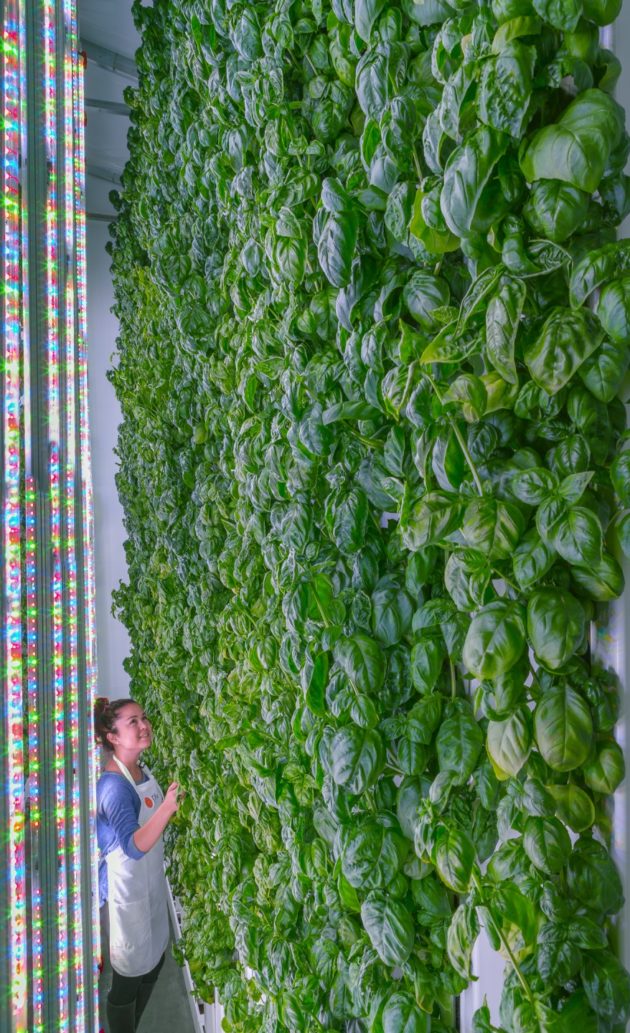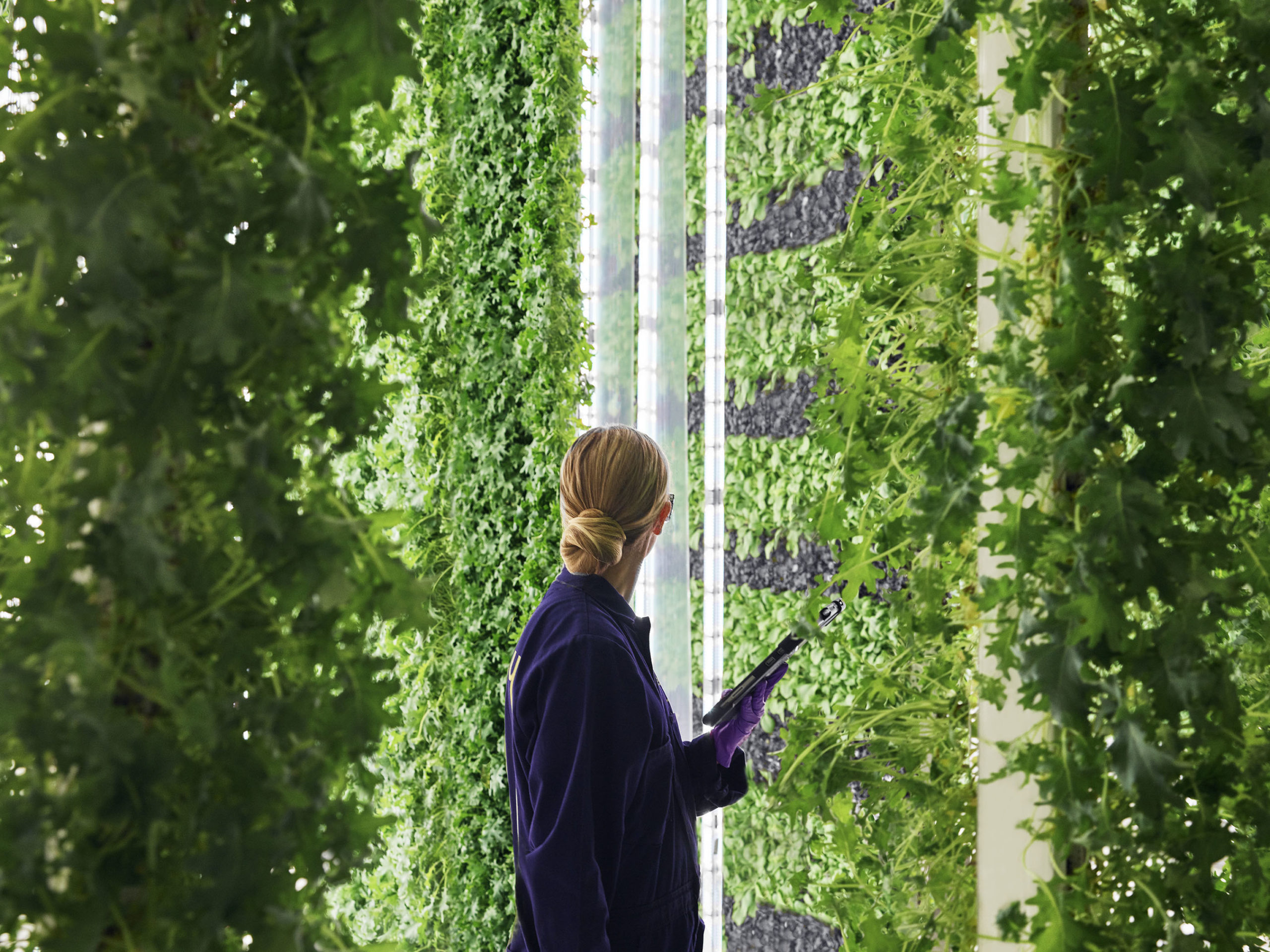Vertical farms have been appearing around the globe as we search for new ways to increase food production. With astonishingly high productivity and low environmental impact, vertical farming may be the solution to feeding a growing population; however, there are trade-offs with every sustainability challenge.
What is Vertical Farming?
Vertical farming is the practice of growing food indoors in a completely regulated environment. All conditions are controlled at vertical farm facilities—including temperature, light, humidity, water, and the nutrients that the plants receive. With a closed-loop system, vertical farms that utilize aeroponic techniques like Plenty and AeroFarms are extremely resource-efficient, using 95% less water and 99% less land to produce about 400 times the amount of food per acre when compared to that of traditional, open-loop system agricultural practices. While this may seem like something from a science-fiction movie, vertical farming might prove to be our path to the future.
Current Agricultural Practices are Unsustainable
In the past century, trends have shown a drastic increase in agricultural productivity with a decreasing number of people who are malnourished worldwide. If this is true, why do we need to change our agricultural practices? Our current system seems to be working!
Unfortunately, our agricultural system is anything but successful. Covering 37% of the planet’s land (excluding Antarctica) and draining 70% of its freshwater resources, agriculture is one of the most environmentally taxing and degrading industries on the planet. It is a leading cause of deforestation and biodiversity loss, making our environment less resilient to the shocks of climate change. Not only is agriculture extremely resource-intensive, but it’s also polluting our soils, waterways, and air with the use of pesticides, fertilizers, and fossil fuels.
The overuse of chemicals to eliminate pests has degraded our soils and decreased the amount of arable land worldwide. Beneficial microorganisms that fill our soils and plants with nutrients are being sacrificed as agriculture becomes increasingly generous with pesticide use. As a result of decreased nutrients in the soil, farms have turned to fertilizers to feed their crops. Often applying more than two times the necessary amount of fertilizer, excess Nitrogen and Phosphorus can seep into our water supplies and run off into streams, polluting the water and resulting in eutrophication. As rivers carry these fertilizers downstream and deliver them to the oceans, dead zones are created. One of the largest oceanic dead zones created by these algae blooms is in the Gulf of Mexico where the Mississippi River connects with the ocean. It is currently the size of Massachusetts.
The high yields and decreasing malnourishment rates we are experiencing now are short-lived. We are approaching a threshold that will alter our global systems permanently once it is crossed. The World Resources Institute predicts that crop yields will decline by 50% in most agriculturally-productive areas of the world by 2050—less than 30 years away. Half of the amount of food produced by our current food system coupled with a population that could reach 10 billion does not follow the positive trend we have been seeing.

The Future of Food
With a warming climate that could increase the average global temperature by 3 degrees Celsius, growing crops outside will be a challenge. Unless we change our current course of trajectory, we will need to shift to new ways of growing our food.
Plenty and AeroFarms are two examples of companies that have emerged in a growing industry of agriculture alternatives. Plenty, located in San Francisco, CA, and AeroFarms, located in Newark, NJ, are changing the paradigm of agriculture with their aeroponic vertical farming systems.
In this process, plant roots are misted with water, oxygen, and nutrients in a perfectly balanced ratio that optimizes plant growth. LED lights provide the plants with the exact spectrum, frequency, and intensity of light for photosynthesis. The plants are grown in a reusable cloth medium which AeroFarms claims prevents plastic waste from reaching landfills or oceans.
On AeroFarms’ website they write, “Our growing cloth medium is made out of BPA-free, post-consumer recycled plastic, each taking 350 water bottles out of the waste stream.”
Additionally, the centrally-located vertical farms near urban areas reduce greenhouse gas emissions by eliminating the typical long-distance transportation. Their produce grows year-round, removing the need to import food during the off-seasons.
“We disrupt traditional supply chains by building farms on major distribution routes and near population centers,” AeroFarms claims on their website. “We defy traditional growing seasons by enabling local farming at commercial scale all-year round. We set a new standard for traceability by managing our greens from seed to package.”
Every year, AeroFarms harvests 2 million pounds of produce from their 70,000 square foot headquarters location in Newark. This is the largest indoor farm in the world based on annual growing capacity—and this is all accomplished without pesticides, fertilizers, or GMOs.
Not only do these vertical farms exceed traditional agriculture in sustainability and efficiency, but the food is nutritious and delicious!
“Fully-controlled agriculture means that we can control, and perfect every aspect of the color, texture, nutrition, and most importantly, flavor of our greens,” says AeroFarms. “We choose the most flavorful varieties of each green we grow and then we use data to make it taste even better. Our kale is sweeter. Our arugula is spicier. Our herbs are brighter. Top chefs agree that our greens have superior flavor, and we have 130,000 data points to prove it.”

Trade-Offs
While vertical farming may seem like the perfect solution to all of our agriculture problems, there are trade-offs with every sustainability challenge. There are limitations to the type of plants that can be grown, technology always has the potential to fail, and a transition away from traditional agriculture could destabilize agriculture-dependent communities.
The limit to the type of food crops grown indoors means that vertical farming alone is not the solution; however, it still has the potential to supply millions and millions of pounds of food in a more sustainable way.
Although technology can fail, vertical farming is more reliable than traditional agriculture. With agriculture’s susceptibility to weather disasters, pest infestations, droughts, etc., the implementation of vertical farms along with more sustainable traditional agriculture practices will make our food system more resilient to external shocks.
If vertical farming ever became a widely adopted farming practice across the world, this may put stress on small agriculture communities that depend on selling their crops to maintain their livelihoods. Agriculture is a part of many communities’ cultures and the domination of large-scale vertical farming corporations could eliminate communities’ traditional lifestyles.
Despite these tradeoffs, vertical farming has the potential to reduce food insecurity and increase food supply worldwide without sacrificing the environment’s health. Vertical farming provides a viable solution to transition a portion of the world’s agriculture to alternative methods so that farmers’ livelihoods remain intact and our environment remains healthy. Our current agriculture practices are leading us to a polluted, unsafe, and unsustainable world. AeroFarms and Plenty are just two of many companies working to create new and sustainable ways that we can manage our food. Together we can change the paradigm of our food system.
Keep up with all of Green Living’s original content online and on social media.





